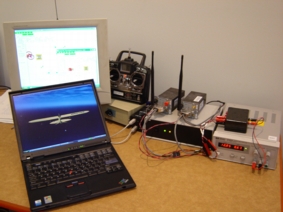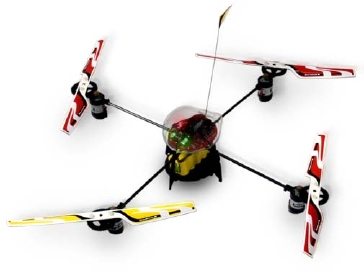Robust, Plan-Driven Adaptation and Control of UAVs
Thomas Léauté, Hui Li & Brian C. Williams
Project Description
The goal of this project is to develop and demonstrate coordination and control methods that allow large collections of autonomous unmanned air vehicle teams to robustly perform tightly synchronized missions in a dynamic and failure prone environment. This project focuses particularly on the health management of the team, by providing control methods that achieve robustness to execution uncertainties, failure of vehicle function and limited communication. This will result in a significant increase in the team's ability to achieve its mission goals without interruption.
Previous research on team operation, in particular, cooperative vehicle path planning (CPP), has focused on performing simple, decoupled tasks, such as visiting a set of locations, by assigning and maneuvering the appropriate type of vehicle to each location. In addition, receding horizon control methods have been developed for these CPP methods that adapt to changes in goal location and environment [3][4].
Little, however, has been said about how to control a team in order to implement a more complex mission specification that involves a tight, temporal coordination of activities, performed by vehicle groups within a team. We refer to this problem as mission-directed, cooperative vehicle path planning (mission-directed CPP). Furthermore, this mission-directed coordination is particularly challenging when taking into consideration constraints on vehicle dynamics, the effects of exogenous, uncontrollable events, and spontaneous loss of vehicle function.
Multi-vehicle search and rescue offers a rich set of examples of mission-directed coordination. One example is fire rescue, in which fire reconnaissance, fire suppression and human medical aid must be well coordinated between air and ground vehicles. Alternatively, the sea rescue portrayed in the book "The Perfect Storm" is a particularly compelling example of robust mission operation under failure, while hostage rescue exemplifies the need for precise timing at key points, despite unforeseen events.
We are driving the development of a robust, mission-directed team operation capability in the context of a series of increasingly ambitious fire, search and rescue scenarios. We ground this work through its demonstration using a hardware in the loop UAV simulation (supplied by CloudCap Technology) (Fig. 1). In addition, we will use the swarm testbed, an indoor, autonomous, electric-powered vehicle hardware testbed, under development by Professor Eric Feron under the Boeing strategic partnership (Fig. 2).
The mission-directed CPP capabilities under development include, but are not limited to, the following:
- Mission-directed, cooperative vehicle activity/trajectory planning based on disjunctive linear program encodings.
- Continuous planning and execution, formulated as a mission-directed CPP receding horizon controller.
- Robust adaptation to uncontrollable temporal events, based on algorithms for dynamic controllability.
- Robust team reconfiguration due to vehicle failure, through dynamic vehicle mission reassignment.
- Distributed variants of the above mission-directed team coordination, under limited communication.
Acknowledgments
This research is supported by The Boeing Company under contract MIT-BA-GTA-1.
References:
[1] See Thomas Léauté's research abstract for more details on his contributions to this project.
[2] See Hui Li's research abstract for more details on her contributions to this project.
[3] Yoshiaki Kuwata. Real-time Trajectory Design for Unmanned Aerial Vehicles using Receding Horizon Control. Master's Thesis, 2003.
[4] John Bellingham, Arthur Richards and Jonathan How. Receding Horizon Control of Autonomous Aerial Vehicles. In Proceedings of the American Control Conference, 2002.
[5] Phil Kim, Brian C. Williams and Mark Abramson. Executing Reactive, Model-based Programs through Graph-based Temporal Planning. In Proceedings of the International Joint Conference on Artificial Intelligence, 2001.
[6] J. Kennell. Generative Temporal Planning with Complex Processes. M. Eng. Thesis, Massachusetts Institute of Technology, October 2003.
[7] I. Shu. Enabling Fast Flexible Planning through Incremental Temporal Reasoning. M. Eng. Thesis, Massachusetts Institute of Technology, September 2003.
[8] J. Stedl. Managing Temporal Uncertainty Under Limited Communication: A Formal Model of Tight and Loose Team Communication. S.M. Thesis, Massachusetts Institute of Technology, September 2004.
The Stata Center, Building 32 - 32 Vassar Street - Cambridge, MA 02139 - USA tel:+1-617-253-0073 - publications@csail.mit.edu (Note: On July 1, 2003, the AI Lab and LCS merged to form CSAIL.) |


